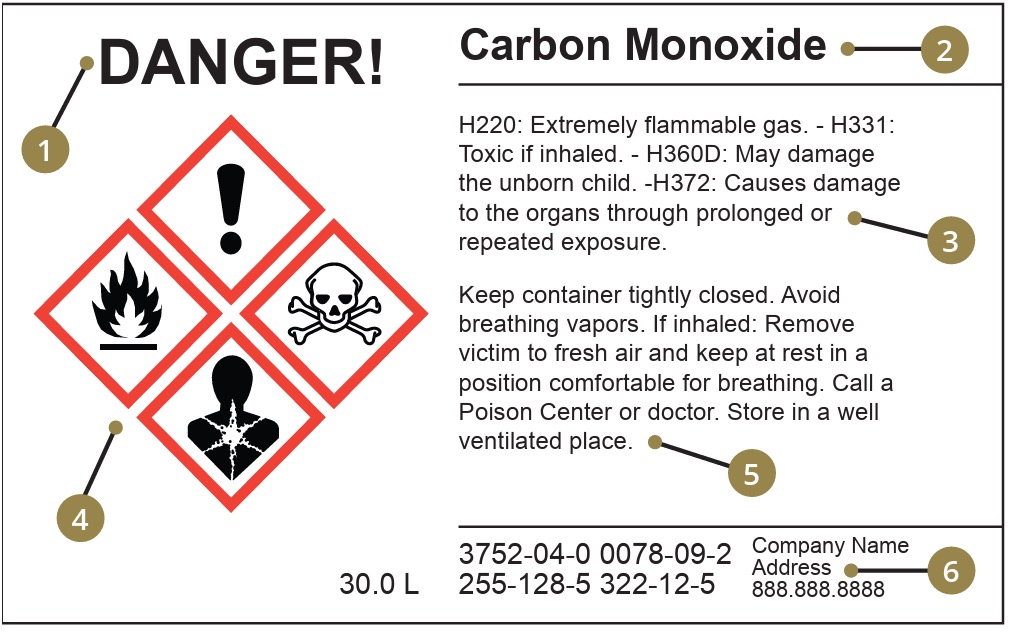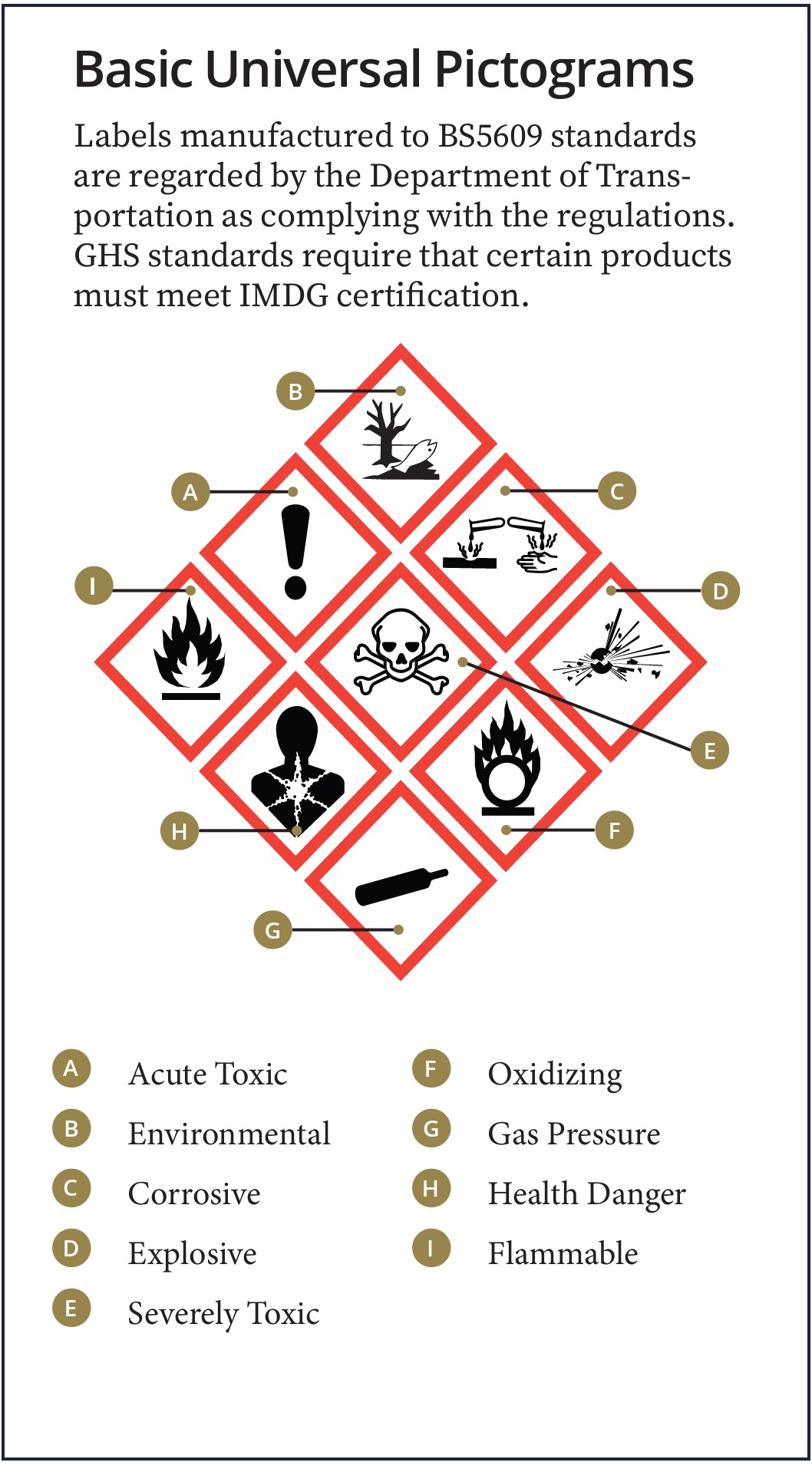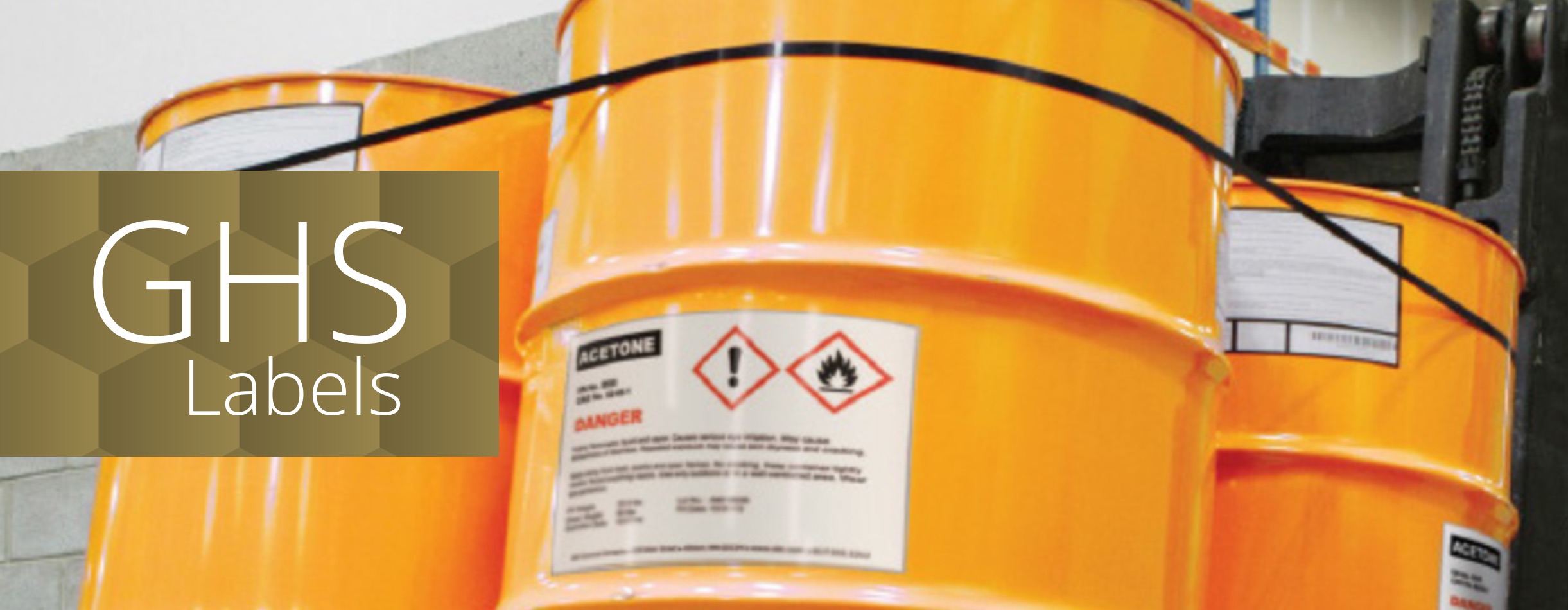Our Pictogram & Chemical Labels are designed to Comply with the Globally Harmonized System.
What is GHS Classification and Labeling?
Why Care About GHS?
What Does BS5609 Mean?
-
1Signal Word: Indicates relative level of hazard. “Danger” is used for most severe instances, while “Warning” is less severe.
-
2Product Name or Identifiers
-
3Hazard Statements: Phrases that describe the nature of hazardous products and often times the degree of hazard.
-
4Symbols (Hazard Pictograms): Convey health, physical and environmental hazard information with red diamond pictograms. May use a combination of one to five symbols.
-
5Precautionary Statements: Phrases associated with each hazard statement that describe general preventative, response, storage or disposal precautions.
-
6Manufacturer Info: Company Name, Address and Phone.
BCS can help you choose the GHS Classification and Labeling that is right for your business. Contact our experts today to learn more: sales@bizcomsolutions.net | 908.429.8574.

Comply with OSHA’s New Hazard Communication Standard

Staying current with OSHA’s revised Hazard Communication Standard and implementing GHS classification and labeling ensures your workplace meets federal requirements and provides employees and emergency responders with clear, standardized chemical hazard information—update labels with the latest pictograms, signal words, hazard and precautionary statements, revise Safety Data Sheets, and deliver targeted training to prevent accidents, streamline audits, and foster a culture of safety.


Key Components of GHS
Classification Criteria
Classification under GHS is like sorting books in a library. Each chemical is “shelved” by its hazard properties—flammability, toxicity, corrosiveness, etc.—based on standardized tests and categories. No more guessing games; you know exactly where that chemical “book” belongs.
Label Elements
To communicate hazards clearly, GHS mandates five core label elements:
Signal Words
- Danger: For the high-octane hazards (e.g., highly flammable, acutely toxic).
- Warning: For hazards that are still serious, but a notch below Danger.
Think of Signal Words as the headline: they catch your eye and set expectations.
Hazard Pictograms
Those red diamonds with icons like flames, skull-and-crossbones, or an exclamation mark are internationally recognized pictograms. They’re like emojis for danger—instantly clear, no translation needed.
Hazard Statements
Standardized phrases such as “H225: Highly flammable liquid and vapor” describe precisely what can go wrong. These statements are the “fine print” that tell you the what, where, and how severe the hazard is.
Precautionary Statements
If Hazard Statements are the diagnosis, Precautionary Statements are the prescription:
- P210: Keep away from heat, sparks, open flames—no smoking.
- P280: Wear protective gloves, clothing, and eye protection.
They guide you on how to prevent or respond to incidents.
Product Identifiers & Supplier Details
Every label must clearly state the chemical’s name or code and list the supplier’s name, address, and phone number. If you have questions at midnight, you know who to call.

FAQs
- What is the main goal of GHS?
GHS aims to standardize chemical classification and labeling worldwide, improving safety and trade efficiency. - How often is GHS updated?
The UN revises the GHS every two years, incorporating new hazard classes and clarifications. - Do I need BS5609 if I only ship chemicals by road?
No. BS5609 certification is specific to maritime transport to ensure label durability in harsh sea conditions. -
Can GHS labels be printed in multiple languages?
Yes. While GHS standardized phrases exist in English, labels can—and often should—include local language translations for clarity. - Are digital (QR code) labels GHS-compliant?
QR codes can supplement GHS labels by linking to detailed safety data, but they cannot replace the mandatory physical label elements.
For Further Reading
OSHA Hazard Communication Standard (29 CFR 1910.1200)
https://www.osha.gov/hazcom/
UN GHS (“Purple Book”) — official UN compendium of GHS revisions and criteria
https://unece.org/about-ghs
European CLP Regulation (EC 1272/2008) — EU’s implementation of GHS in the Classification, Labelling & Packaging (CLP) framework
https://ec.europa.eu/growth/sectors/chemicals/classification-labelling_en
EPA Hazard Communication Guidance — EPA’s overview of how GHS fits into U.S. chemical safety practice
https://www.epa.gov/hazcom
BSI BS 5609 Water-Resistant Label Materials — official British Standards Institute page on marine-grade label testing
https://www.bsigroup.com/en-GB/bs-5609-2-water-resistant-label-materials/
ISO 7010 Safety Signs and Pictograms — for standardized red-diamond/triangular hazard symbol specs
https://www.iso.org/standard/72406.html
TALK TO OUR EXPERTS TODAY www.bizcomsolutions.net | sales@bizcomsolutions.net | 908.429.8574 | https://www.linkedin.com/company/business-communication-solutions-llc

